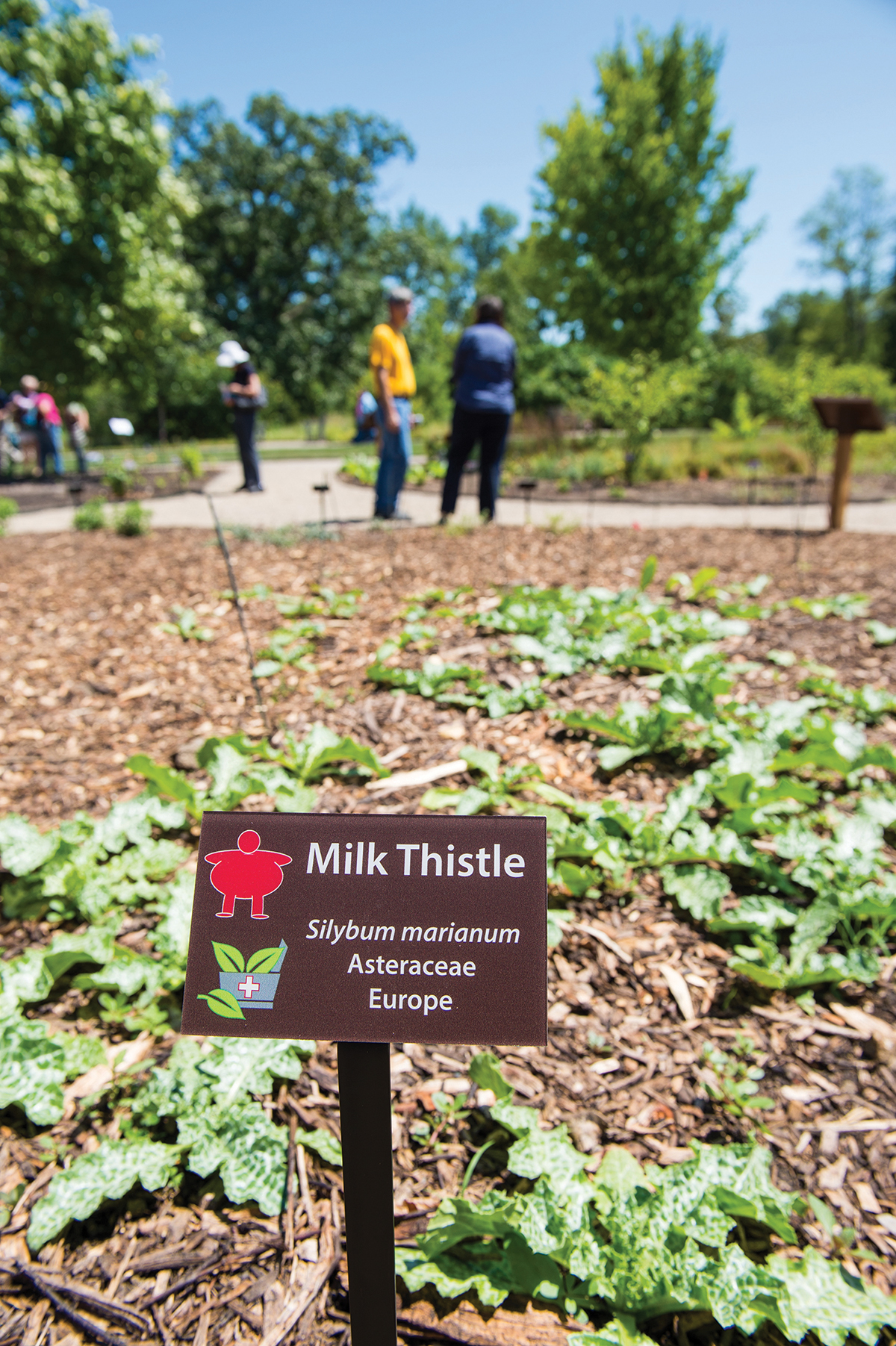By Angela Madaras
Upon arrival the Matthaei Botanical Gardens may seem a bit intimidating, with a barrage of rattlesnake warning signs posted along the long winding drive through the wild, prairie-like, bucolic setting. But once you pay for your parking at the self-pay port and enter the arboretum or gardens, you are transported to a happier place from within the deep recesses of your childhood memories. It is altogether beautiful, peaceful, and engaging. There are many display gardens and areas of interest, but this article focuses exclusively on the outdoor Medicinal Garden.
Created with slight hills that are connected with a paved foot path, and separated by individual beds that are woven into one spatial plot to the left side of the conservatory, the garden is comfortably dotted with spots to sit in sun or shade. The plants it features have immeasurable value for uses in medicinal and culinary preparations. Through its design and signage, this garden explores and informs the viewer about the hidden properties behind each plant and the historical connection to a similar U-M garden from the 1800s. Here the past meets modern technology.
I met Dr. Sara Warber here on a hot summer’s day for a hands-on tour and to talk about the intention of and her involvement with the creation of an outdoor teaching medicinal garden. Sara told me that the layout was set up for the visitor as a cognitive map, arranged by disease and/or body system, as you can see in the signage and plan layout. For example, one might want to find herbs that ease respiratory ailments or cardiovascular issues. The layout, combined with graphic signage, makes it easy to navigate to where one’s interest lies.
According to the website for the University of Michigan Matthaei Botanical Gardens and Nichols Arboretum:
The medicinal garden at Matthaei recalls the earliest botanical gardens at U-M and contains a wealth of contemporary information on plants and the medicines derived from them. The plants are arranged by the body system or disorders and diseases they are meant to treat, such as infectious diseases, cardiovascular, digestive, and others. The Medicinal garden will promote a better understanding of the profound relationships between plants and human health…[and] provides an educational experience where visitors and the university community can immerse themselves in an environment of healing.
Plants, health, and medicine share a long history together. The unique role of plants in health and wellness encompasses both the foods we eat and many of the medicines we take. Today nearly 40% of pharmaceuticals in the United States used to treat human disease are derived from plants or were originally derived from plants, according to the University of Michigan’s Dr. Sara Warber [now retired] in the Department of Integrative Medicine.
Dr. Warber is now providing consultation to the World Health Organization, and finds that patients around the globe are increasingly more interested in herbal medicine. Dr. Warber’s knowledge and experience with herbal medicine led the garden’s Director, Bob Grese, to involve her with the planning of the garden and in deciding what plants to include. When I met with Dr. Warber, I asked her about how they intended to use the garden space beyond just for display. She and other professors used the garden as a classroom for the medical fellows studying Integrative Medicine and other curricula at The University of Michigan. They also brought in another group, “Faculty Scholars in Integrative Healthcare”; faculty members from many different U-M schools of varied disciplines, who over the course of a year studied about natural medicine. They spent a whole day in the garden, where they engaged in an herbal scavenger hunt. They had to find and identify plants not only in the garden, but also in the greenhouse. They were tasked to describe the plants and their uses, and then share that information with the group. This was one of the highlights of Sara’s career. Many others also contributed significantly to the experience of the Faculty Scholars’ day, including local herbalist Linda Diane Feldt, who was present during this event as a consultant. In addition, Suzanna Zick, a naturopathic physician who is currently the co-director of the Integrative Medicine Program at the University of Michigan, helped on the herbal teaching end, but was not directly involved in the garden itself.
In keeping with their innovative approach, the developers of the garden wanted an updateable electronic link, so there is a QR (Quick Response) barcode on every plant sign. A lot of research and vetting went into finding the herbs and describing their properties in an up-to-date and reliable way. The viewer who brings a phone or tablet can scan the QR to access information about the plants, including more evidence-based data, since this is always changing. This is very important for the younger, tech-savvy generation.
I have joyfully visited the garden a couple of times since it opened, and I always find something new or interesting to study. I found it extremely educational and inspirational at once. I even was inspired to plant several of the herbs in my own medicinal garden, including a tall, perennial foxglove that has white, thimble-shaped flowers, and the leafy green and slightly stinky valerian, with the tiniest, tender, white flowerets. Each of these is featured in the Medicinal Garden: foxglove*(please see update below—identified as digitalis) in the “Cardiovascular” section, and valerian in the “Affective” grouping. Both plants can be used for making teas and other preparations. For example, I make a tincture as a sleep aid from valerian, which shares at least linguistic roots with today’s modern sedative medication called valium.
I have taken others to visit this patch as well and have had only positive responses. Of course, we need to pay attention to our surroundings and wear proper shoes/boots when enjoying the great outdoors, while also being mindful that we are in a natural environment where other creatures live and thrive. We are their guests! It is important that we do not pick, eat, harvest, or cut any of the plants, which are there for all to enjoy. At certain times of the year there are plant sales listed on the website, so people can purchase and grow plants that have caught their eye during visits.
We received this message from a reader who is an experienced herbalist and that we thought we should share this information. *Drinking tea made from foxglove is not only incredibly dangerous, but has been deadly, and can be deadly in one cup (a colleague of mine had a friend die from mistaking foxglove for mullein). Foxglove looks very much like comfrey, and fatal poisonings have resulted from confusing those plants, too (https://www.ncbi.nlm.nih.gov/pubmed/28463019).
You can visit the medicinal garden at the Mattheai Botanical Gardens, 1800 N. Dixboro Rd. Ann Arbor. Winter hours are 10 a.m. to 4:30 p.m. daily and Wednesdays until 8 p.m. Learn more online at: mbgna.umich.edu





















































































































































































Having watched the moon set with the sun’s rising, the ancient lunar goddess Hekate is on my mind. And near the Huron river path this morning, a pokeweed plant reaches upward offering a message and posing a hieroglyphic sign as she raises her arms in slender scarlet sleeves. Fresh green pendants nestle beside fully ripe ink-purple fruit on her supple limbs where she drapes luxurious flowing tresses, trailing glossy clusters from slender stems. Wildly flowering, the goddess and plant step from forest edge as one to emerge into the waking world. Hekate dances within her chosen ally pokeweed, just as ancient Greeks thought nymphs ensouled their trees in mutual lifelong union.